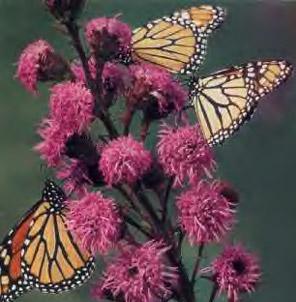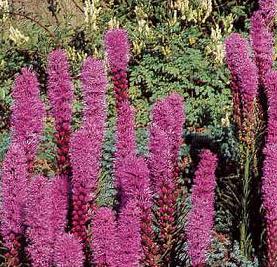Liatris Seed ( Perennial )
There's probably nothing more versatile and easy to grow in the garden than liatris blazing star plants. These 1 to 5 feet tall plants emerge from mounds of narrow, grass-like leaves. Liatris flowers form along the tall spikes, and these fuzzy, thistle-like blossoms, which are usually purple, flower from the top to the bottom rather than in the traditional bottom to top blooming of most plants.
In addition to their attractive blooms, the foliage remains green throughout the growing season before turning into a rich bronze color in fall.
Useful gardening information
Growing liatris plants is easy. These flowers provide many uses in the garden. You can grow them nearly anywhere. You can grow them in beds, borders and even containers. They make excellent cut flowers, fresh or dried. They attract butterflies. They're relatively pest resistant. The list can go on and on.
While they are commonly grown in full sun, many types can also take a little shade. In addition, these plants effectively handle drought and are fairly tolerant of cold as well. In fact, most are hardy in USDA plant hardiness zones 5-9, with some varieties of liatris hardy in Zones 3 and 4 with mulch. Grows in many soil types, including rocky terrain.
It should be noted that plants grown from seeds don't bloom until their second year.
Liatris seeds can be started indoors or sown directly in the garden. Germination usually occurs within 20 to 45 days if the seeds are exposed to cold, moist conditions for about four to six weeks prior to planting. Sowing them outdoors in the fall or early winter can often yield good results.

JB079 Meadow Blazing Star ( Liatris ligulistylus )
Considered one of, if not the best Monarch Butterfly attractors. The beautiful purple blossoms of this Liatris should be your first choice for attracting Monarch and other butterflies to sunny, medium-soil sites in late summer. It's not uncommon to see dozens of Monarchs nectaring on a stand of Meadow Blazing Star. It blooms primarily in August, just when the Monarchs are preparing for their long migration south; a synchronization that has evolved over hundreds of years, and a good example of how native plants and pollinators are deeply dependent on one another.
These upright plants can reach 5' in rich soils; in a garden setting you may want to stake them. The height of this Liatris make it an easy target for Monarchs and other butterflies and birds to feed. Blossoms often appear all at once along stems and last for many weeks late summer. Birds find the seeds appealing later in the year.
A perennial best suited for zones 3-7.

D2266CD Kobold Dwarf Goblin Blazing Star ( Liatris spicata )
Dwarf, dense violet spikes in early summer, grassy foliage, striking appearence.
A hardy perennial plant reaching only 16" tall ft.with rosy purple spikes
of flowers reaching 15" in length. Excellent for dried or
cutflower arrangements.



